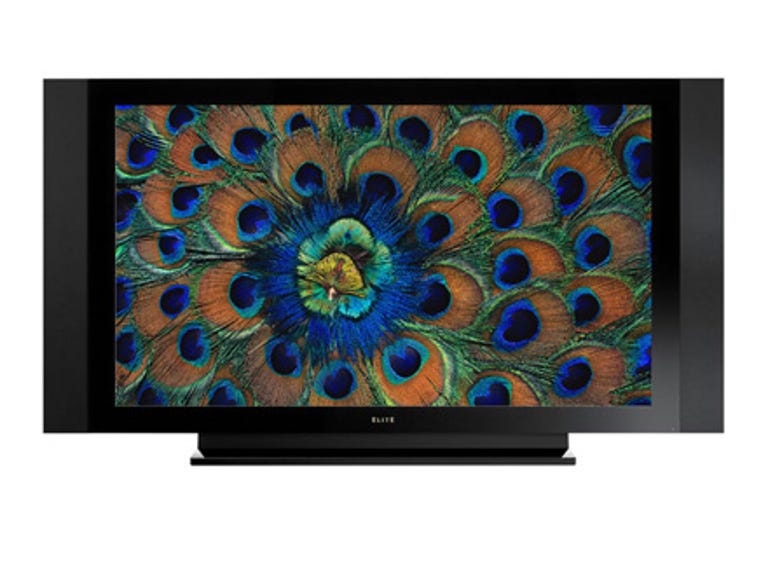 Why You Can Trust CNET
Why You Can Trust CNET Pioneer PDP-LX608A review: Pioneer PDP-LX608A
The Pioneer PDP-LX608A is an amazing full-HD 1080p screen, and justifiably sits at the apex of the company's plasma range.
The Pioneer PDP-LX608A is the flagship of the company's plasma range, and boasts features and performance which blows every other TV away. But is it worth the extra outlay on the Editor's Choice winning PDP-508XDA?
The Good
The Bad
The Bottom Line
Design<
Let's start off by saying this: we're not kidding when we tell you that this is a bloody huge TV! At 168 centimetres in width (with speakers), even the most demanding home cinephile will struggle to justify anything larger. Really, the next step from here is a 1080p projector.
The reason for the massive dimensions? Well, apart from the 60-inch screen diagonal itself, the bezel is quite thick, and the speakers also add around 20 centimetres. Of course, though these are included in the package you can opt not to install them for a svelte look.
Like all of Pioneer's LX range, the PDP-LX608A features a piano-black bezel which may or may not appeal to house-proud owners -- the reason being is that this finish seemingly acts as a fingerprint and dust tractor beam. It can extract prints at a distance of 10 feet! (Actual results may vary.) Jokes aside, this is a premium grade TV and it certainly looks it.
The remote will be familiar to owners of other Pioneer plasmas with its solid and weighty metal finish. Where it differs from the Pioneer 5000EX's, for example, though is that it can also control other HDMI-CEC compatible products (Pioneer's only, at this stage). This also means that it's covered in buttons and can be confusing at first.
Features<
The PDP-LX608A range boasts a further increase in black levels on the XGA models (the PDP-428XDA and PDP-508XDA) with a true 20,000:1 contrast ratio -- none of this pretend "dynamic contrast" for Pioneer. This is due to improvements in the waffle structure of the screen -- the plasma cells are closer together letting less light leak out.
Other features of the PDP-LX608A include a 1080p resolution, a USB port for viewing photos from cameras, three HDMI ports, an HD tuner onboard (the previous 50-inch flagship model, the PDP-5000EX, lacked a tuner), and improved video processing.
Like many prestige panels, the Pioneer PDP-LX608A features several key technologies for removing judder. If you're not familiar with it, judder manifests itself as jerky motion when it should appear smooth -- usually occurring during sweeping camera shots. These video defects are most obvious on large panels, and hence the 100Hz and 24p modes are implemented on the Pioneer to eradicate them.
Performance<
The Pioneer's screen is sufficiently bright to perform well under fluoro lighting, with sufficient black levels and a lack of reflections. Of course, turn the lights off and the blacks deepen even further -- putting every other panel on the market to shame.
The image processing engine was especially impressive, with the Pioneer seemingly able to make a purse from the sow's ear that is analog broadcasting. As you'd expect, the image quality wasn't as good as via digital tuner, but for areas which can't receive digital it's not as bad as we were expecting. In fact it's probably the best analog reception we've seen -- and this is welcome due to the fact the large screen is capable of exposing flaws in any image.
The digital tuner, on the other hand, was very good, with sport and chat shows alike looking detailed, with natural colours and relatively free of noise. One annoying thing, though, was the amount of lag when changing stations, which was usually four to five seconds each time.
Standard definition, in the form of DVD, looked especially good. We fed a signal from the Samsung 1080P7 -- there was a lack of artefacting on close-ups of Naomi Watts' face during the climactic Empire State building scene in King Kong. Indeed the long shot of Kong on top of the building usually exposes some MPEG errors with even the most expensive players, but this combo gave us an artefact-free experience.
Mission Impossible 3 on Blu-ray is a fairly grainy film, but the image processing of the Pioneer was intelligent enough to distinguish between the grain and actual digital noise, making for a gritty but detailed image.
The only negatives to this screen are the slight cross-hatched "noise" we noticed on PC playback -- similar to what we saw on the PDP-508XDA -- and a rainbow effect in your peripheral vision which may unnerve some viewers.
Conclusion
The Pioneer PDP-LX608A is an excellent screen, but it's not for everyone. The price, for one thing, sees to that. This is now one of the most expensive screens on the market, but it's of sufficient quality that it's a justified expense.
Also, as we've mentioned, this is a very large TV and suited to very large living spaces or dedicated theatres. But if you've a sufficiently bulging wallet and room to burn then this is a fantastic television.


